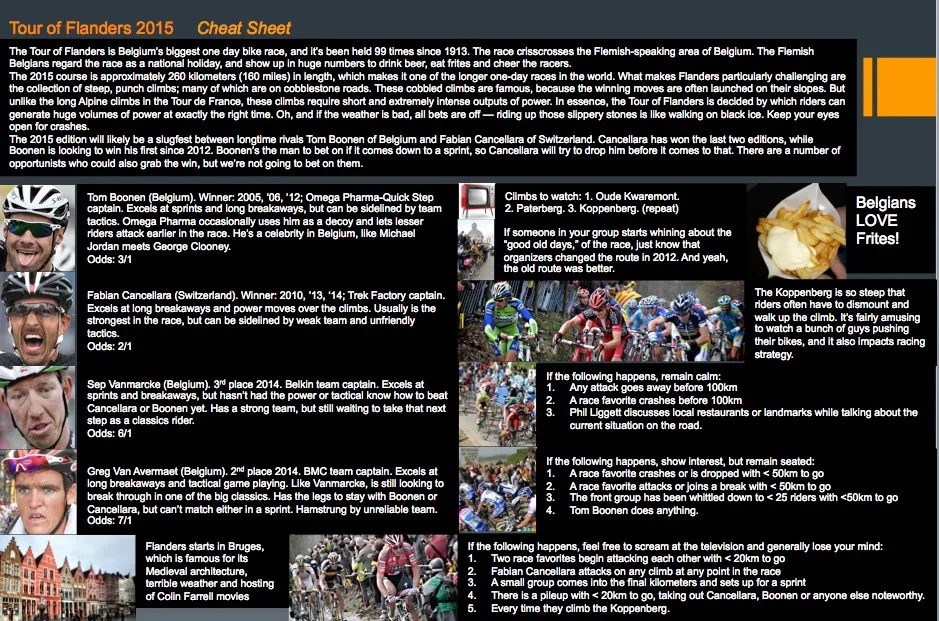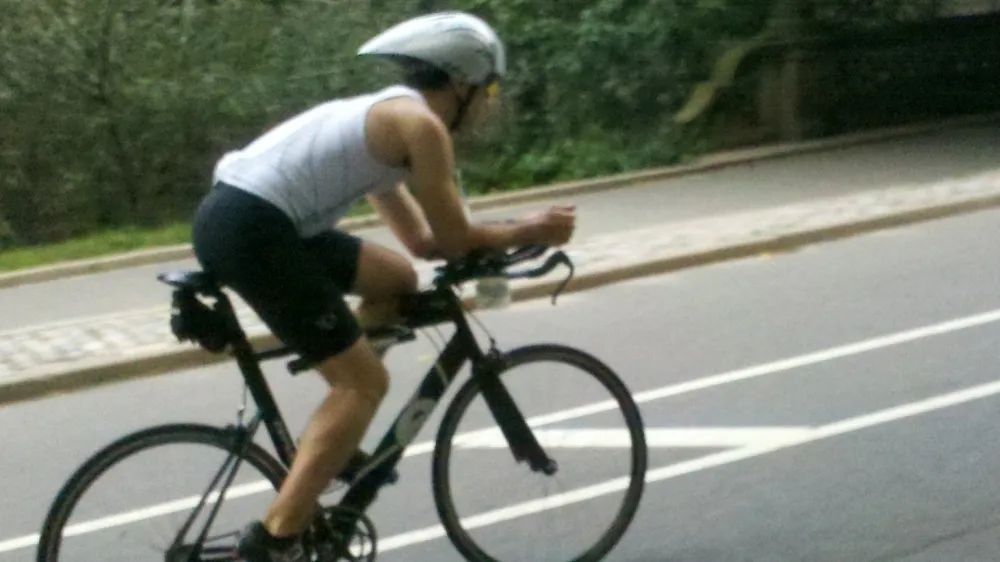At BikeRadar, we strive to bring you the best inventions and innovations from the bike world. But in this column, contributor Fred Dreier explores his own wacky bike ideas, and consults various experts as to their validity. Warning: these ideas are anything but fully baked.
We’ve all experienced the following scenario: You turn on the television or fire up your computer to watch a big pro race, and your spouse, parent or friend sits down to watch. He or she immediately begins peppering you with questions.
- If they’re on the same team, how come they’re from different countries?
- Why doesn’t somebody ride ahead of the group?
- Those guys are 10 minutes ahead, so they’re going to win, right?
- Could Froome beat all of these guys? What about Lance?
You proceed to discuss cycling’s nuances and strategy, and then totally miss the decisive attack on the screen.
Problem 1: Watching bike racing with non-cyclist friends is a drag.
Half-Baked Cycling Idea: Bike Racing Cue Cards
There are multiple products on the market that provide educational material for cycling neophytes, from the Tour de France’s annual guide to the Tour de France For Dummies.
But magazines are cumbersome, and handing your spouse a book to read could get you slapped.
The Bike Racing Cue Card is a double-sided, laminated cheat sheet that explains the basic concepts in bike racing while also delivering race-specific information. For example, the Paris-Roubaix edition would discuss the agony of racing a bicycle on bumpy pavé, give a list of favorites and display a photo of Roger De Vlaeminck’s weather-beaten mug.

I pitched my idea to journalist James Raia, who wrote The Tour de France For Dummies, and also frequently writes about cycling for mainstream newspapers. Based on his experience with mainstream editors, Raia gave me a list of newbie questions my cards will need to answer.
- How does drafting work?
- Why are trade teams comprised of multiple nationalities?
- How do they go to the bathroom?
- What do they eat?
- Why does 25th place get the same time as 1st place in a sprint?
- Why do they shave their legs?
Raia said cycling’s team tactics are the most challenging aspect for newbies to grasp. His strategy is to compare concepts in cycling to other well-known sports.
“I use the chessboard analogy — domestiques are the pawns, and you let them go out early and then get blow away,” he said. “When their jobs are done, then the bigger chess pieces like rooks and bishops get to battle it out.”
Raia liked my plan, but said that the hurdle will be explaining everything in such a limited space. Some concepts, like drafting or team tactics, require pages of explanation to fully explore. There is another important part of cycling that newbies usually don’t get.
“There are three things I don’t talk about in a bar: politics, religion and Lance Armstrong,” Raia said.
Duly noted.

When I lived in New York City, I regularly spotted road cyclists who needed some tips on etiquette and style. Minor offenders brought their US$3,500 racing wheels on casual rides. More serious misfits wore their time trial helmets on the group ride, or haphazardly sped around Central Park.
Problem 2: The goofball cyclists in my community have no etiquette.
Half-Baked Cycling Idea: Hire a “Bike Etiquette Pro” to teach cyclists good etiquette and style
I’m sure you’re familiar with the tennis pro concept. A country club invites some retired legend to teach tennis lessons and school guests on how to walk, talk and dress like a respectable tennis player.
Is there enough of a market, however, to just target nitpicky stuff like style and etiquette?
I posed my question to Australian racer Ben Day, who recently ended his 13-year pro career to launch his own coaching business, Day By Day. Day liked the idea, but he said that my preoccupation with etiquette and style is missing the point. Misfit etiquette often points to more serious problems with a rider.
“Guys can get strong fast, but things like skills take longer to develop, and you see that when you look at them on the bike,” Day said. “Maybe a guy is strong, but he can’t ride elbow-to-elbow in a group or handle his bike in traffic.”
Many novice cyclists get strong quickly, but they skimp on learning basic bike skills, proper handling and yes, etiquette. So perhaps that guy wearing the TT helmet in Central Park is also a two-wheeled missile of doom. Teaching him to slow down isn’t easy, Day said.
“It’s tough to convince people to take a step back, because they are preoccupied with fitness,” he said. “It’s tricky — at a certain point you’re challenging someone’s ego.”
Day said he learned the ropes from the Kangaroo Cycling Club back home in Brisbane, where the older members would police the bunch for poor riding or bad etiquette. In the absence of clubs, coaches can offer services. Day also proposed his own Half-Baked Cycling Idea for my etiquette question.
“Let’s say you own a bike shop — why not offer a free skills class to anybody who buys a bike?” he said. “Think about the community benefit you’d be offering.”
I like it, Ben.
